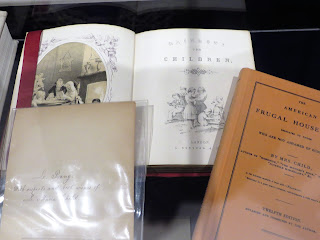. . . and her name is Helen Marshall! Greetings from Nantucket. The year is 1861. I am Helen Marshall. I guess you could say I'm of Nantucket but not from Nantucket.
Until I was 9 1/2 I lived on board a whaling ship! My grandfather is the famous Nantucket whaling captain Seth Pinkham, who died in Brazil before I was born. My mother was his daughter Malvina. My father, Joseph Marshall, is also a whaling captain.
 |
| My father (left) Me (right) |
My mother refused to stay behind though she was soon to be delivered of a child-me. I was born in the Azores, a group of islands off the coast of Portugal. I spent my first eight years on board a whaling ship.
 |
| Nantucket whaleships stopped in the Azores for provisions and crew. That is where I was born.. |
We sailed around the Pacific with my father, visiting many exotic locales and returning with a full cargo of sperm whale oil. I loved learning about the places we went and the people we met.
 |
| Liverpool Creamware for the American market |
Liverpool Creamware- some of the less exotic treasures we brought home. (Your modern day sensibilities would be offended if I showed you our finest treasures). I like how each jug is personalized with patriotic American images and the name of the ship. Sometimes even the name of the captain or family is included.
 |
| My toys |
I had many toys to amuse myself during the long voyages. I used this set of carte-de-visite featuring images of kings and queens of France and England to learn history. I wrote genealogical notes on the back of each card. Second Mate George B. Hussey of the Aurora made this jump rope for me. It has whale bone handles and fancy sailors' knots. I also learned to tat lace with this tattling shuttle you see above.
This is my doll, an Izannah Walker doll
I stitched this little quilt for my doll. I tried to trade it to a sea captain for a dog.
I save photographs of friends and family in albums. The top photographs are my little cousins. The bottom photographs are my half-brother's children.
 |
| My grandfather's desk. He wrote many letters home with long-winded advice. |
 |
| Nantucket vs. the world. |
Let me show you what the town of Nantucket looks like.

 |
| Nantucket- the center of the whaling industry for many years |

One of the most important buildings in town-the lighthouse. The light keeps ships from running aground. This is the new light from 1849. It is a Fresnal lens created by a Frenchman. The light is built around a central piece of glass (the bull's eye). It is surrounded by concentric rings of glass projecting beyond one another. This type of light allows 5 times more light to shine than a traditional convex lens.
There are many industries in Nantucket. Each one has a distinct odor. Over 200 women and some girls like me braided straw into hats and bonnets.
Behind me you see the newest American flags. The flag had 30 stars when my father left on his first whaling voyage in 1849. The stars represent the states including Wisconsin. Now our flag has 31 stars. California is the newest state.
In the distance you see a homeward bound pennant. Flags served as long distance communication tools at sea. A red homeward bound pennant shows a whaleship is heading home.
 |
| Local businesses |
 |
| Nantucket 1850s |
The whaling industry is still king here but it is not what it used to be. I will spare you the gruesome details of a whaling voyage. Behind me is a sperm whale skeleton. This is the type of whale my father and his crew sailed after. They are clever and cunning beasts. The blubber and bone of whales is highly prized for oil and other things.
 |
| A barrel we used to store whale oil |
The sperm whale has a waxy oil found inside a mysterious organ in their heads. We call it spermaceti.
This oil can be used to make odorless candles- a big improvement over tallow (pig fat). It can also be used to grease machines.
 |
| Spermaceti oil and candle molds |
That concludes my tour of Nantucket. I hope to see you in New Bedford some day to pick up the story where I just left off.
Helen Marshall went on to study at Vassar College. Helen set off on a grand tour of Europe in 1876 with her friend Ann Mitchell Macy, sister of Maria Mitchell. Upon her return, she taught at Nantucket High School and later at the Norwich Free Academy in Connecticut. She died in 1939.
_____________________________
Editorial note:
 |
| Pinkham-Marshall Family |















































